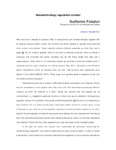
Please use this identifier to cite or link to this item:
http://ricaxcan.uaz.edu.mx/jspui/handle/20.500.11845/185| Title: | Nanotechnology regulation context |
| Authors: | Foladori, Guillermo |
| Issue Date: | Sep-2015 |
| Publisher: | Nanoscale Science and Technology Center |
| Abstract: | After more than a decade of sustained R&D in nanosciences and nanotechnologies, together with its growing presence within market, the countries are slowly starting to regulate those products which contain nano-objects. These materials evidence different properties as when their size is bigger [2]. So, for instance graphite, which is soft and an electrical conductor, when is worked in nanoscale and converted into carbon nanotube may be 100 times harder than steel and a superconductor. Gold, which is not chemically reactive as we know it, becomes reactive when in nanoscale and it is useful, therefore, for making sensors (Rao, 2011). According to the Woodrow Wilson International Center for Scholars there are over 1 800 products with engineered nano-objects in the market (WWICS, 2012). These range from sporting goods to weapons of war, and from food to cement and paints. |
| URI: | http://hdl.handle.net/20.500.11845/185 |
| ISSN: | 1533-4880 1533-4899 |
| Other Identifiers: | info:eu-repo/semantics/publishedVersion |
| Appears in Collections: | *Documentos Académicos*-- UA Estudios del Desarrollo |
Files in This Item:
| File | Description | Size | Format | |
|---|---|---|---|---|
| Foladori, Guillermo. Nanotechnology regulation context.pdf | Versión publicada | 357,87 kB | Adobe PDF |  View/Open |
This item is licensed under a Creative Commons License
